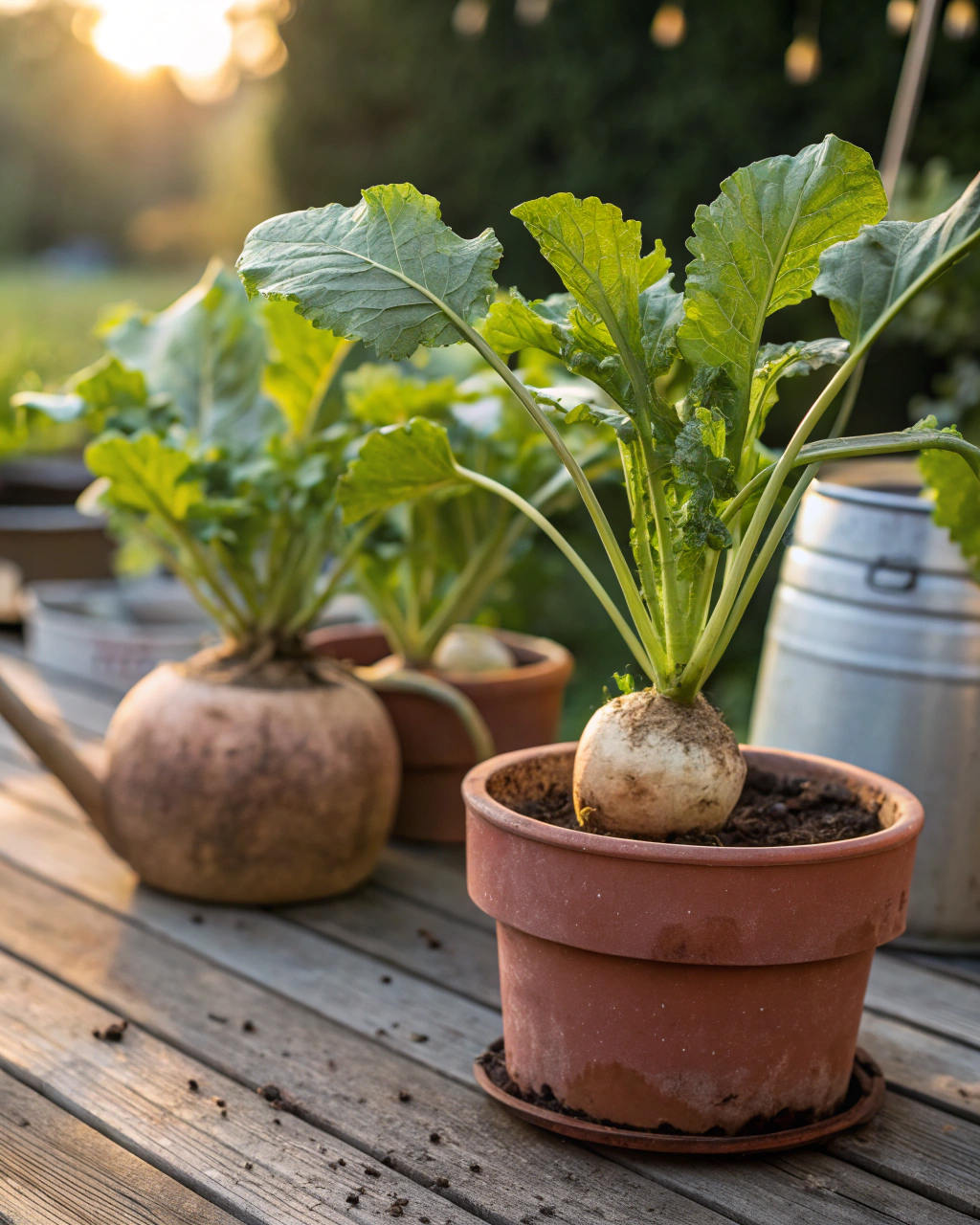Why Grow Turnips in Pots for Fresh Autumn Harvests?
If you’ve ever wanted a crisp, peppery root vegetable fresh from your own garden, turnips are an unbeatable choice — especially in pots. You don’t need a sprawling backyard or perfect soil to enjoy them. With just a few simple steps, you can grow sweet, tender turnips right on your balcony, doorstep, or patio. Autumn is the perfect time: cool nights and mild days coax the best flavor from the roots. You’ll love the satisfying crunch of a homegrown turnip, the beautiful splash of purple or white against green leaves, and the handy freshness that store-bought just can’t match. Plus, turnips mature quickly — in just **70 to 90 days** — so your patience pays off fast. I’ll guide you through every step, with clear advice to avoid common pitfalls and grow abundant, flavorful turnips without fuss.
Getting Ready — What You’ll Need
To grow turnips successfully in pots, gather these essentials first. Each plays a key role in supporting healthy roots and vibrant tops:
- Containers: Choose pots at least 30 cm (12 inches) deep and 25 cm (10 inches) wide. Turnips need room for their roots to swell. Clay or ceramic pots work well (great for hot climates since they keep soil cooler), but large plastic pots or wooden boxes with drainage holes also suffice.
- Drainage: Ensure your pots have multiple drainage holes. Without them, waterlogged roots will rot quickly.
- Soil: Use a loose, well-draining mix — aim for about 70% loam for nutrients and texture, 20% compost for organic matter, and 10% coarse sand or perlite to enhance aeration.
- Fertilizer: Choose a balanced, low-nitrogen option (such as a 5-10-10 NPK). Too much nitrogen will encourage leafy growth but stop roots swelling.
- Seed variety: Pick quick-maturing, dependable types suited to autumn, like ‘Purple Top White Globe’ or ‘Hakurei’ (an extra-sweet, mild turnip). Both do well in pots.
- Light: Location should provide at least 6–8 hours of full sun daily. Partial shade is fine in hot regions to protect leaves.
- Tools: A hand trowel for planting, a watering can or hose with a fine rose, and gloves for soil prep.
If you’re budget-conscious, substitute expensive potting soil with homemade compost mixed with garden loam and coarse sand. Repurposed containers like old crates lined with landscaping fabric can work too. Just keep those drainage holes open!
Step-by-Step — How to Grow Turnips in Pots
1. Preparing Your Pot
Start by thoroughly cleaning your container to remove any old soil and disease spores. If you’ve grown vegetables here before, sterilize the pot with a dilute bleach solution (about 10% bleach), rinse well, and let dry completely. This step helps prevent fungal problems later.
Next, create a drainage layer at the bottom of the pot using 2–3 cm (about 1 inch) of coarse gravel or broken terracotta shards. This stops water from pooling and suffocating roots.
Fill the pot with your prepared soil mix—remember, that balanced 70% loam, 20% compost, and 10% sand ratio to ensure drainage and nutrients. Avoid packing the soil too tightly; you want it crumbly and airy, like a damp sponge wrung out. Compact soil limits root expansion and invites disease.
Do not forget drainage holes. No holes mean soggy soil and root rot. Also, double-check your soil pH; turnips prefer slightly acidic to neutral soil, around pH 6.0–7.5. Use a simple soil test kit if you’re unsure.
2. Sowing or Planting
Sow your turnip seeds directly into the pots as they germinate best without transplant shock. Plant seeds about 0.5–1 cm (¼ inch) deep. Sprinkle them evenly but allow space, aiming for about 5 cm (2 inches) between seeds—that’s enough room for roots to develop individually.
After sowing, gently firm the soil with your fingertips but don’t crush it. The soil surface should feel just moist and firm, not dry or crumbly. Turnip seeds prefer soil temperatures of around 10–15°C (50–60°F) for steady germination, typical in early to mid-autumn.
Pro tip: Soak your seeds in lukewarm water for 4–6 hours before planting. This softens their tough coat and improves germination speed.
3. Watering and Sunlight
Keep the soil consistently moist but never soggy especially during germination. Water your pot deeply until excess moisture seeps through the drainage holes—usually about 2–3 times per week under typical autumn conditions. Adjust frequency based on weather and pot size; smaller pots might dry faster.
Stick your finger into the soil about 2 cm deep. If it feels dry at this level, it’s time to water again. Avoid watering leaves directly to reduce disease risk.
Turnips thrive in 6–8 hours of bright sunlight daily to develop sturdy leaves and robust roots. If you live in a cloudy or shaded area, move pots into the sunniest spot available or use reflective surfaces nearby to increase light. In hot, dry climates, provide afternoon shade or group pots together to keep moisture from evaporating too fast.
4. Feeding and Maintenance
Feed your turnips with a balanced liquid fertilizer low in nitrogen every 3–4 weeks once seedlings have developed two sets of true leaves. Too much nitrogen from fertilizers will make plants leaf-heavy but small-rooted — we want the opposite.
Thin seedlings when they reach 3–4 cm tall. Remove smaller or damaged ones to maintain spacing of about 7–10 cm (3–4 inches). This gives turnips room to swell. Use small scissors or pinch them out rather than pulling, to avoid disturbing nearby roots.
Loosen soil gently between plants with a small fork or finger to avoid crust formation, which can stunt growth.
Watch leaves for signs of yellowing or stunting — these often reflect nutrient imbalance or overwatering. If you see pale leaves, add compost tea or a seaweed-based feed to boost micronutrients without overloading nitrogen.
“The secret is not more work — it’s regular care and observation.” — This is my favorite gardening truth. Checking your plants frequently helps you catch problems early.
5. Troubleshooting While They Grow
- Yellow leaves: Too much nitrogen causes heavy leaf growth but weak roots. Switch to a fertilizer with higher phosphorus or add bone meal.
- Stunted growth: May indicate insufficient light or poor drainage. Move pots to sunnier spots and ensure holes aren’t blocked.
- Diseased or spotted leaves: Fungal or aphid invasion. Remove affected leaves and treat with insecticidal soap or neem oil.
- Soil remains soggy: Check pot drainage and avoid watering too often. Let top 2 cm (¾ inch) dry out between waterings.
- Misshapen roots: Soil too compact or seeds planted too close. Mix in coarse sand and thin seedlings carefully for proper root shape.
6. Harvesting
You’ll know your turnips are ready to harvest around 70 to 90 days after sowing, depending on variety. Look for firm, well-rounded roots about 5–7 cm (2–3 inches) in diameter. The skin should be smooth, taut, and brightly colored — creamy white, purple-topped, or tan.
Gently loosen the soil around the root with your fingers, then pull the turnip straight up. The root should feel solid and heavy, not spongy or shriveled. You might hear a slight snap or feel subtle resistance as it releases from the soil.
Pro tip: Reduce watering during the last week before harvesting. This concentrates sugars and enhances sweetness, giving your turnips a better flavor.
After harvest, store turnips in a cool, dark place between 4–7°C (39–45°F) with moderate humidity, for up to 2 weeks. Longer storage may lead to softness or bitterness. You can also pickle, freeze, or dry turnips for longer preservation.
Extra Tips for Perfect Results
- Companion plants: Try planting onions, garlic, spinach, or radishes nearby. They deter pests and improve soil health.
- Rotate pots: Change your pot’s location each season to reduce soil fatigue and disease buildup.
- Mulch: Apply straw, shredded leaves, or bark mulch on top of soil to keep moisture steady and regulate temperature.
- Use rainwater: If possible, water with collected rain. Tap water can cause soil to harden up over time, making roots struggle.
- Wind protection: Cluster pots where there’s a natural windbreak or between buildings to reduce drying and mechanical damage.
- Shade on hot days: Use a light fabric or garden shade cloth during intense midday sun to prevent leaf scorch and wilting.
Common Mistakes and How to Fix Them
- Overwatering: Roots become soft and rot. Fix this by letting the top 2 cm (¾ inch) of soil dry before watering again and checking drainage.
- Weak growth: Usually caused by too little light. Move pots to a sunnier location immediately.
- Yellow leaves: Excess nitrogen from fertilizer. Switch to a formula higher in phosphorus and potassium.
- Poor germination: Seeds planted too deep or in cold soil. Limit sowing depth to 0.5–1 cm (¼ inch) and start in moderately warm soil, around 10–15°C (50–60°F).
- Misshapen roots: Soil that’s too compacted or seedlings left too close. Mix in coarse sand or perlite to improve airflow and carefully thin plants.
Harvest and Storage
Harvest your turnips gently to avoid damaging the root or green tops. Use your fingers or a trowel to loosen soil around the bulb before pulling upwards. Avoid twisting, which can snap delicate stems.
For storing fresh turnips, keep them in a dark, cool spot with temperatures around 4–7°C (39–45°F) and humidity near 90%. They’ll keep firm and flavorful for up to 2 weeks. If longer storage is needed, pickling is a great option — sliced turnips preserved in vinegar develop a zesty crunch. You can also blanch and freeze them for winter soups and stews.
If you want to save seeds, leave a few turnips to bolt (flower and set seed) in early summer. Harvest seed pods after drying thoroughly, then store them in labeled envelopes away from moisture.
What Success Looks Like
There’s something quietly triumphant about pulling your first perfectly round, firm turnip from a pot you prepared weeks ago. The root’s smooth skin, sharp purple crown, and the faint earthy aroma tell you it’s fresh and nutrient-rich. Expect a yield of about 1–2 kg (2–4 lb) per container, depending on pot size and care. Crisp, juicy, and slightly sweet with a peppery bite, every turnip is a reward for your careful watching and watering.
But more than the vegetable itself, what truly matters is the connection you’ve built with the soil and the rhythms of nature. Every thinning, watering, and gentle pinch is part of a learning journey — one where patience and observation are your best tools.
Mini Recap — Your Success Checklist
- Pot depth: At least 30 cm (12 inches)
- Soil mix: 70% loam, 20% compost, 10% sand
- Watering: 2–3 times per week, adjusting to soil moisture
- Sunlight: 6–8 hours daily
- Fertilizer: Every 3–4 weeks, low nitrogen
- Harvest: 70–90 days after sowing
Closing Reflection
Growing turnips in pots isn’t about perfection — it’s about consistent care, attentiveness, and learning with each season. Every plant you nurture teaches you a little more about timing, soil, light, and your unique environment. Don’t rush your turnips, watch them daily, adjust when needed, and enjoy the process. That patient rhythm, that connection with the earth, that’s what makes you a gardener. Soon enough, you’ll bring fresh autumn harvests from a simple pot, and with them, a deep satisfaction that only home gardening can give.

Hi there — I’m Ava, the creator behind Ava Garden Tips 🌿
I’ve always been passionate about plants, flowers, and the simple joy that comes from growing something beautiful. What started as a small balcony garden has turned into a love for helping others create their own green spaces — no matter how big or small.
